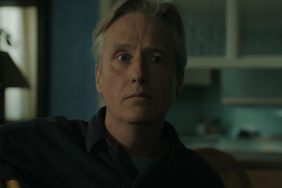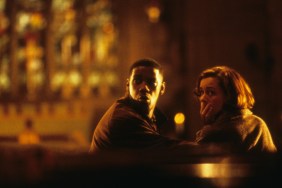ComingSoon.net talks with director Breck Eisner about The Last Witch Hunter, starring Vin Diesel
As the son of one of the most powerful executives in Hollywood, Breck Eisner has long had to create a name for himself with the films he directed, which includes Sahara, starring Matthew McConaughey, and 2010’s remake of George Romero’s The Crazies.
For his latest movie The Last Witch Hunter, Eisner teams with action superstar Vin Diesel in the title role as Kaulder, an immortal who has to work with the Order of the Axe and Cross to keep dark witches and sorcery in check in modern-day New York City. It co-stars Michael Caine and Elijah Wood as Kaulder’s “handlers” and “Game of Thrones” star Rose Leslie as a witch called a “Dreamwalker” who Kaulder must turn to for help in taking on a new threat.
ComingSoon.net spoke to Eisner over the phone a couple weeks back shortly before The Last Witch Hunter had a panel at New York Comic-Con, and we were able to cover quite a bit of ground, but focusing on the film’s impressive visual FX work.
ComingSoon.net: I’m surprised we haven’t spoken before, because you’ve been making movies as long as I’ve been writing about them.
Breck Eisner: Right. Well, I’m really thrilled to be able to talk to you and talk about this movie with you, for sure.
CS: I heard the story about how Vin met Cory the screenwriter and talked to him about Dungeons & Dragons, and how it escalated from there. I don’t know how you actually got involved. Was it just simply that a script got to you and you were interested?
Eisner: The specific is that Cory’s manager is a guy named Adam Goldblum, and Adam had hired me to do the first episode of a show called “Fear Itself,” which was the evolution of “Masters of Horror” from Showtime to NBC for a short little stint one summer. We got along really well, and so, he exposed Cory’s script to me when it was finished, and I immediately said, “I have to do this movie. This is fantastic.” So I met with Cory and then Cory had told me he had written it with Vin in mind, which I loved the idea of, and then I got the movie when it became available.
CS: I have to imagine a lot of the world building was already done in some ways, at least not visually, but at least as far as the mythology of what was going on. While reading it, did you have a pretty good idea of how you wanted the visuals to look to match that?
Eisner: It’s interesting. When you first read the film, you have an initial idea of what the visual world will be, what the look of the movie’s going to be. It immediately morphs as you start to develop and create the movie. Of course, there were things that were touchpoints from Cory’s script like The Great Witch Tree, which was the initial inspiration of what the medieval witches looked like and what their world building is going to be like, this connection to nature. So from that simple idea, it just exploded forward and developed from there. The way I like to work is I pull images from all sources and line them up on the walls and pin things up on the walls and I have a wall of things I like, and in this case, a wall of things I don’t like, and how witches have been portrayed in cinema in the past, I think oftentimes, not well. So I would go through what I was really digging, what I wasn’t digging, and then I would bring in a couple of concept artists and talk it through and start sketching ideas and really start from the ground up of just building this world. It really is building a world from scratch, and that was what was so fascinating for me about this film.

Eisner: (Laughs) We did talk about all Terrence Malick. We talked about “The Lion King” tree. We talked about any other tree in there and how trees have been portrayed in film in ways that are memorable, for sure, yeah. I mean, the scale of this tree, the idea of an action type of piece taking place inside a tree kind of sets the scale of the design.
CS: Obviously there’s a lot of folklore and fables and fairytales about witches. If you’ve lived in New York as long as I have, you learn that there are those that practice Wiccan here. Did you do a lot of reading on your own, to try to get into that kind of world or realm to incorporate?
Eisner: Yes, certainly. The importance of grounding everything in a reality as much as we can, and then deviating from that where we wanted to, but being aware of what truly exists, what horrors have existed in 49] the past, the horrors that have existed, where it wouldnhave been unjust to be tarred as witches and the use of that in the most evil ways and recognizing that. Also, recognizing where the idea of witches came from and the Hexan mythology. All of that ancient text as well as modern ideas of witchery, witchcraft were things that we studied, and of course, studied a great deal before we started, and then, decided to just go on it on our own and do our own mythology that was unique to the film. The idea of bringing this movie to New York was one, however, that was never a wavering in terms of it being the melting pot of the world. It also seemed to be the melting pot of witches in our existence, that it would be the place where everybody would congregate as one group and was the most accepting of all of the different groups.
CS: I think your Comic-Con panel later will be a really interesting mix of a melting pot. I’m really curious to see who shows up there because it will be a combination of Vin’s fans as well people dressed in black, should be interesting.
Eisner: I think it’s going to be fascinating. We are one of the few panels up there I think that has no connection to source material at all, whether it’s books, existing movies, graphic novels, cartoons, TV shows, characters that existed. We are what is unique and rare in this world, which is a completely unique idea in this genre from no source material, just a script. I’ll be very curious to see if people are reacting to something brand new and are open to something brand new and willing to come see us talk about something new and unique. It’s one of the things that was really fascinating to me about the project is the last movie I did was a remake of a George Romero film, and I loved doing it, but in this case, I wanted to try and do something wholly original, to see if we could pull it off.
CS: But it’s also more of a challenge, too, especially for marketing, to try and sell a movie like that. You obviously have Vin, who is a force and is really good at marketing himself.
Eisner: For sure. I think in Lionsgate’s mind–and they’ve been great with the movie and great with marketing the movie–I believe, is that Vin is the IP (intellectual property). Everybody knows Vin Diesel. Everybody loves Vin Diesel, and he is something that people recognize. I think in this age, people like to recognize elements of the filmmaking that they go to, and whether it’s a story that’s being retold or reinvented or filmmakers they know or an actor that they really know. I think there is a connection to the audience that is really important to get them to the theater. It’s hard to get people to the theaters these days. People are so busy and their time is pulled in so many directions that our challenge as filmmakers is to create something that people want to go to the movie theaters to see.
CS: Absolutely. Now I want to get back into some of the logistics of the movie. I know you’re a big fan of physical makeup and sets and I know you’ve built a lot of it. Can you talk about trying to decide how to integrate the VFX? You obviously didn’t have a $200 million budget, but you had a lot of things you had to do effects wise. Can you talk about deciding how much to do on set and how much to do afterwards?
Eisner: Yeah, one of the challenges of the movie is certainly that we didn’t have the budget of a Marvel movie or a “Fast and Furious” movie, if you will. I mean, we had a healthy budget for a unique idea and I was so happy to have it, and I want to try and create a world that feels immersive and feels whole and complete. The way to do that is through on-set production as well as on-set visual effects as well as post digital effects. I think the effects are best done in this day and age when you combine all three, when you have as much on set as possible and it augments what’s there with the digital elements, rather than leave everything to post.

So the sets were of the interior of the Great Witch Tree–we built as much of that as we could possibly afford, all the foreground, mid-ground and even some of the backgrounds and did minimal set extension there, so that the actors could feel like they were really there, that the light interacted with everything, that the threats were around the corner, that they were really there.
The character we call the Sentinel, which is this animated, dark rock and wood creature which the head of the witch council uses magic to bring it to life, and we had a local artist in Pittsburgh, where we shot, build a full one-to-one full-scale replica of the design of this creature, and we had that in any scene where it existed. We had that creature there in the environment so we could light it, actors could react to it. When we did set pieces where it was running through these mines in the Pittsburgh area, where we shot it, we put the thing on a big cart and pulled it with a truck through the environment so we could see how it interacted with the environment. I think that kind of effort is really important. It takes time and it’s hard to convince the producers and the AD to let you take the time, and they need to let you take the time to shape these things, but in the end, they’re really beneficial to creating better visual effects. The Visual Effects Supervisor called it “gold dust,” that you don’t leave to an artist interpretation in post what the lighting effects are, but you in fact, have a true representation of it, and it’s known exact about what it looks like and how it interacts. It’s very helpful.
CS: I spoke to Roland Emmerich recently, and he was talking about how the visual effects has really improved over the years. Normally, a movie like this would cost upwards of $200 million because of the amount of visual effects, and you couldn’t make a really good-looking movie without that money. The artists and animators have gotten better I assume.
Eisner: I think it’s amazing how much better visual effects have become. However, the challenge is that there are so many more movies and television shows using visual effects that there is a strain on the number of animators and artists available. It’s not just about the right visual effects houses, and not just about how you prep a designer, but it’s about having the right supervisors within each house, and having the right artists working on the visual effects. It is artistry from the top down. It’s all about these craftsmen and these artists and supervisors, and making sure that they understand how to do it and understand what makes it cinematic and what makes it feel right and work right and move right. All of that as an art and the technology is important, but it’s the people running the technology that’s going to either make it work or not work.
CS: Very well said. While the movie has horror elements, it’s not a horror movie, but the fact that you have it coming out in October, it might get that bump from horror fans looking for something a little more horror-based. Could you talk about balancing that and trying to get some of those elements in, and also deciding a PG-13 rating and going for that rather than something gorier and bloody?
Eisner: Yeah, we never really wanted to make it a horror film. I love horror films and I love horrific elements within movies that are not necessarily horror films, and there were definitely moments that I wanted the audience to be scared, and there are definitely moments that I want you to be in the dark, and I wanted the threat of the most dangerous witches to be scary. It’s not a bright, silly film by any stretch of the imagination, but there’s no blood in the film. I wanted to avoid blood and guts and some of the tropes of horror films. The movie “The Crazies,” I certainly did not avoid that. I think it worked well in that film, but I think in this film, it wants to tilt a little more towards fantasy and towards science fiction and towards action and adventure than it does towards horror.
CS: Do you have any idea what you want to do next? I’m assuming before you got this script, you were developing other things as well. Do you have anything else you want to do?
Eisner: I do, but not anything I’m talking about yet, but I have a bunch of projects I’ve been developing and will continue to develop, but I’m taking a little bit of a break to be with my family for a couple of months before I disappear again, but yes, I’m going on to a couple of other projects shortly.
The Last Witch Hunter opens in theaters nationwide on Friday, October 23 with previews on Thursday night. You can check out our interview with Vin Diesel here.
(Photo Credit: Ivan Nikolov/WENN.com)
The Last Witch Hunter
-
The Last Witch Hunter

-
The Last Witch Hunter

-
The Last Witch Hunter

-
The Last Witch Hunter

-
The Last Witch Hunter

-
The Last Witch Hunter

-
The Last Witch Hunter

-
The Last Witch Hunter

-
The Last Witch Hunter

-
The Last Witch Hunter

-
The Last Witch Hunter

-
The Last Witch Hunter

-
The Last Witch Hunter

-
The Last Witch Hunter

-
The Last Witch Hunter









